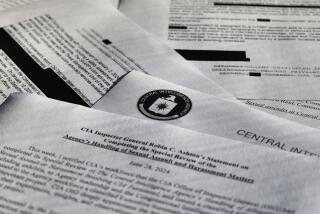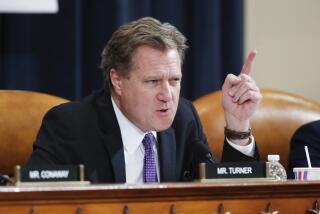CIA, FBI Disagree on Urgency of Warning
- Share via
WASHINGTON — The one thing everybody agrees on is that a CIA cable transmitted Aug. 27 over a classified government computer network warned that two “Bin Laden related individuals” had entered the United States and that two other suspected terrorists should be barred from entering.
The CIA had already notified the White House and other senior policymakers in early August that the exiled Saudi militant Osama bin Laden was determined to launch a terrorist attack within the United States.
For the record:
12:00 a.m. Oct. 20, 2001 FOR THE RECORD
Los Angeles Times Saturday October 20, 2001 Home Edition Part A Part A Page 2 A2 Desk 1 inches; 25 words Type of Material: Correction
CIA cable--A story Thursday incorrectly reported the date that the CIA sent a cable to the FBI and other U.S. agencies about four terrorism suspects. The cable was sent Aug. 23.
But CIA and FBI officials now disagree over the significance of the later notice and, specifically, whether an apparent miscommunication affected the FBI’s response.
The FBI failed to find two men who later emerged as suspected skyjackers Sept. 11. Khalid Almihdhar and Nawaf Alhazmi, the two men identified on the CIA cable as already being on U.S. soil, helped seize an American Airlines jet after takeoff and crash it into the Pentagon, killing 189 people.
The argument underlines the sometimes bitter communication problems between the two agencies at the front line of America’s war on terrorism. The CIA insists the cable was coded “immediate” in capital letters at the top. The agency uses four alert levels--routine, priority, immediate and flash--but flash is reserved only for the most serious events, such as outbreak of war.
Immediate, said an intelligence official, means “It’s an emergency. It’s rare you would get a cable anything higher. This is the upper end of the scale.”
The official, who read parts of the classified cable to The Times, said it warned that the four suspected terrorists, including Almihdhar and Alhazmi, had “confirmed links to Egyptian Islamic Jihad operatives.” U.S. intelligence believes the Egyptian Islamic Jihad, one of the world’s most ruthless terrorist groups, merged with Al Qaeda last June in Afghanistan.
The cable also disclosed that Almihdhar met with “Bin Laden associates” in Malaysia in January 2000. That meeting, which the CIA later viewed on a videotape, has become a key link in the current investigation. The agency concluded that Almihdhar had met a man that it believed was a prime suspect in the bombing of the U.S. destroyer Cole in Yemen in October 2000.
The cable added that Almihdhar flew into New York’s John F. Kennedy International Airport on July 4 and that Alhazmi flew into Los Angeles on Jan. 15, 2000. It does not mention the Cole and provides no other information about the two other suspected terrorists. Those two other suspects, U.S. officials said Wednesday, did not play a role in the Sept. 11 attacks and are not believed to be in the United States.
Several FBI officials gave a markedly different version of the cable’s contents Wednesday, however.
An FBI official who was involved in the episode but asked not to be identified said that the CIA cable was not coded “immediate” and gave no other indication of its urgent status. He said the agency requested only that the Immigration and Naturalization Service put the four men “immediately” on a special watch list.
“That was the purpose,” the official said. “The purpose of the cable was not to tell the FBI to do anything.”
“I saw no reference in the cable to any kind of priority. Whether there was some sort of CIA code or something, I don’t know . . . [but] there’s nothing up front that lights this thing on fire that we can tell.”
Still, he and other FBI officials insisted that the bureau acted aggressively after receiving the CIA cable at its counter-terrorism unit in Washington. Agents saw it as a promising lead on the Cole investigation, one of the bureau’s highest priorities.
“As it was treated, it was urgent in the sense that we had no idea where this person [Almihdhar] was and we wanted to figure out where he might be,” one official said.
The FBI analyst on the case spoke frequently with her counterpart at the CIA regarding the cable and made immediate contact with the INS to track down information on Almihdhar.
Field agents were sent first to check Marriott hotels in New York, the address Almihdhar had given when he arrived in July, and then at Sheraton hotels around Los Angeles, the address he gave on a previous trip. They found no record that he ever had stayed in a hotel.
The FBI went back to the INS on Sept. 10, hoping to find another lead.
“It moved along very quickly,” even though “there’s nothing [in the cable] that suggests an imminent terrorist threat. This is not about a warning of an imminent threat,” said the FBI official, but rather about looking for a potential witness in a past attack.
The official praised the FBI analyst’s performance, and said an internal review after Sept. 11 had found that “everything was done that could have been done.”
Other FBI officials also defended the bureau’s response. “The point is, we acted upon it immediately,” one official said. “We did not take that information from headquarters and travel by horseback to New York.”
Several suggested the CIA was over-dramatizing the cable’s importance and questioned the agency’s motive in disclosing the cable’s contents now.
“If the cable says, ‘Don’t let them in the country, and they were already in the country,’ what’s the point of bringing this up now?” one FBI official asked.
The U.S. intelligence official conceded that the FBI had very little to go on. “They had the guy’s names, passport numbers and last addresses. It would be very difficult to find someone based on that. . . . And they didn’t.”
The official said he couldn’t explain why the CIA version was marked “immediate,” and the one the FBI received was not. He speculated that the coding had been stripped out in the FBI computers.
“I don’t know what happened on [the FBI] end,” he said. “Anywhere else in government, when it says ‘immediate,’ it gets a higher degree of attention. And this definitely says ‘immediate’ in capital letters.”
The cable may have been changed as it moved through official channels. One law enforcement source said his version began with an instruction that read, “The following information is provided for lead purposes only and is intended solely for the background information of recipients in developing their own leads.” That language doesn’t appear on the original CIA cable.
The cable also was addressed to the State Department’s Intelligence and Research office, the Customs Department and the INS.
Bill Strassburger, spokesman for the INS, questioned why it took so long for the CIA to share its intelligence. Had the notice arrived earlier, for example, the INS might have prevented Almihdhar and Alhazmi from entering the country.
“My understanding is it’s not a situation where we had the information and didn’t act on it, but [a situation where] the information didn’t get to us in time,” Strassburger said.
The head of the State Department’s Bureau of Consular Affairs, Mary Ryan, complained bitterly at a Senate hearing last week that consular offices could have stopped more of the suspected terrorists from entering the country if the CIA and FBI had shared more of their intelligence with the State Department.
“It is a colossal intelligence failure, or there was information that wasn’t shared with us,” Ryan told a Senate Judiciary subcommittee. “What went wrong is we had no information on [the hijackers] from intelligence and law enforcement.”
Ryan said that Mohamed Atta, a suspected cell leader in the Sept. 11 plot, received a U.S. visa, for example. But intelligence agencies know now, and apparently knew before, that Atta had met with Bin Laden operatives earlier in the year. “I’m surprised how much we learned in the immediate aftermath” of Sept. 11, she said.
Ryan said the FBI has refused for a decade to provide the State Department with access to its National Crime Information Center databases, including one on gang and terrorist group members, because the State Department is not a law enforcement agency.
INS Commissioner James Ziglar told the same hearing that the FBI only recently granted the INS, a fellow Justice Department agency, access to the databases, and then only at two entry points into the United States. He did not say where, however.
The Times reported Sunday that a simple check of public records and addresses from the California Department of Motor Vehicles would have shown the FBI that Almihdhar and Alhazmi had been living at a series of addresses in the San Diego area.
Similarly, a check with credit card companies would have shown that Alhazmi used a Visa card in his own name on the Internet to purchase a ticket on Flight 77 on Sept. 11. He bought the ticket Aug. 27 and gave an address in Fort Lee, N.J., according to law enforcement records.
Moreover, if the FBI had provided the airlines with the two men’s names, the airlines could have alerted authorities to their travel plans and prevented them from boarding. Since the attacks, airlines have been receiving watch list names and checking them against ticketed passengers.
The CIA and FBI long have bickered over the sharing of intelligence information, partly a result of their widely different cultures. CIA agents steal secrets and harvest intelligence in furtherance of U.S. policy. FBI agents seek to solve crimes. CIA sources and methods are secret. FBI evidence must be acceptable in open court.
Efforts to bring the two camps together have included the posting of an FBI special agent as deputy director of the CIA counter-terrorist center, and the posting of a senior CIA official in the FBI’s counterpart operation.
On Sept. 16, CIA Director George J. Tenet issued a classified memo to agency leaders calling for better cooperation in the war against terrorism. The memo later was circulated to other top figures in the nation’s intelligence community. It was first reported by the New York Times. Portions were provided Wednesday to the Los Angeles Times.
Tenet said the “unrelenting focus” of the CIA’s “operational, analytical and technical capabilities” should be protecting the United States from further terrorist attacks and destroying Al Qaeda and its allies.
“There can be no bureaucratic impediments to success,” Tenet wrote. “All the rules have changed. There must be an absolute and full sharing of information, ideas and capabilities. We do not have time to hold meetings to fix problems. Fix them--quickly and smartly.”
Tenet said the CIA should employ the same “principles” in dealings with law enforcement, military, civilian and other intelligence agencies.
“Whatever systemic problems existed in any of these relationships must be identified and solved now,” he said. “There must be an absolute seamlessness in our approach to waging this war--and we must lead.”
Since then, according to the CIA, the agency has made a greater effort to provide briefings to people on Capitol Hill, at the Treasury, State and Defense departments, as well as the FBI.
“We’re reaching out to more people without being asked, and telling them what we know,” said one official. “We’re grabbing people by the lapels to make sure they’re hearing what we’re hearing.”
*
Times staff writer Jon Peterson in Washington contributed to this report.
More to Read
Sign up for Essential California
The most important California stories and recommendations in your inbox every morning.
You may occasionally receive promotional content from the Los Angeles Times.










